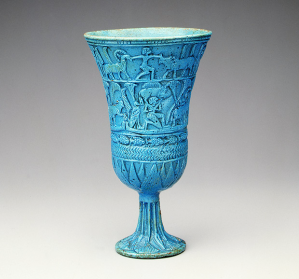This is a piece of pottery, beautifully shaped into a glazed blue cup. There are carvings on the side of the cup that show ancient Egyptians with animals, seemingly domesticating them. The cup curves out at the top and rounds at the bottom with another protrusion at the base to hold the cup up. There are leaf- looking carvings at the base of the cup, that portrays a flower growing around the bottom of the cup.
One of the depictions carved into the cup seems to be portraying a man forcefully separating two animals, which seem to be some sort of oxen or sheep. There is a strip of swimming fish around the cup near the bottom, as well as a strip of a zigzag pattern, which both appear to be for design purposes.
The title of this piece is “Lotiform Cup,” which indicates that the leaf- looking design at the bottom symbolizes a lotus flower. It may be called “Lotiform” as a combination of “lotus” and “cuneiform,” as in the carvings of the cup. The description mentions that the water lily was valued during ancient Egypt because it opened its petals each morning to the sun, so it was a symbol of recreation and rebirth.
“Lotiform Cup” falls into history during the Third Intermediate Period, when chalices like this were carved with “relief scenes,” which caused myths to arise of the, “birth of the king as child of the sun god out of the watery marsh environment, and thus the renewal of the world out of the flooded land of each midsummer New Year.” This means that the involvement of animals in this carving of the cup is relevant perhaps to the symbolism of rebirth to the blue water lily, which is of main importance on the cup. The fish and animals may symbolize the flooding of the land each midsummer New Year, which brought crops and animals, and was a renewal of life for the Egyptians.
During the Third Intermediate Period, there was a weakening of centralized power because it began after the death of a prominent ruler, Ramesses XI. Power was passed around, and there were not many major structures built. There was great technological advancement with bronze, and the statuary of temples, gods, and kings thrived. This was a time of political aspiration, social identification, and artistic production in ancient Egypt. This can all be seen in the artistic achievement shown within the craft of this cup, and the person that shows dominance over the animals may represent the dominance of humans over the land.
With all background knowledge, I can conclude that this “Lotiform Cup” is symbolic of renewal of life and aspirations for success. The true meaning has to do with a human’s interaction with nature, and the Egyptian society gaining control over their politics and social statuses. It shows celebration and revival.

This report is very informative and does a good job at explaining the significance and meaning of the art. You have gone very in depth as to how each aspect of the cup relates to the time period it was made in ancient Egypt. Thanks to your analysis I understand that during Egypt was experiencing great prosperity thanks to a growing amount of interaction and technological advancement.
LikeLike
The choice in art is meaningful because you chose a piece that revealed much of the success found in the Egyptian civilization. However this selection only acknowledges the perspective of those in Egyptian culture benefiting from development, therefore choosing a piece that depicted Egyptian culture from an slave, or non-egyptian would have been a more thoughtful choice that gave a unique perspective and added to your peers learning.
LikeLike
Your OPTICC report does a very good job explaining this time period. The Context section supplied me with the most information, and I was very impressed with how you tied the information back to the creation of the cup. One concern I have for you is fact checking, although I am not sure, I believe the writing style in Egypt was used with hieroglyphs, not cuneiform, so I believe your evaluation of the title of this piece is wrong. However the analization you did of the lotus flower was very thoughtful and informational, so overall you did a very good job analyzing this piece and relating it to the time period.
LikeLike
Affer speaking with you, I know you chose this from the Metropolitan Museum online database. This is already proof that your choice of art is meaningful, as I know from my own experience there is a lot of art to choose from. Your analysis on the chalice provided a very clear description of the meaning behind the artwork, although I agree with Gus’s statement that choosing a piece of art that reflected a different level of the hierarchy would have benefitted my knowledge more. Overall great choice!
LikeLike